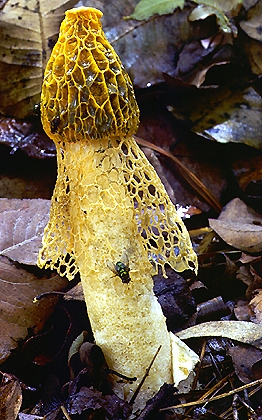
Dictyophora multicolor Berk. & Broome

Common name: Crinoline Fungus, a name derived from the beautiful orange lattice-work veil or indusium.
Description: Normally up to 20 cm high, the crinoline fungus can sometimes reach a height of 30 cm. It emerges from a gelatinous textured egg which may be up to 3 cm in diameter and is sometimes pink-tinted. The fungus expands rapidly (sometimes within half an hour). The spongy white or pink stem is hollow. The cap is orange, but is usually covered by the olive, slimy and strongly foetid spore mass. The indusium (the lattice-work veil) is usually bright orange but pink and yellow varieties may be found. The length of the indusium is also very variable, sometimes reaching only half-way down the stem, while in other specimens the veil reaches almost to the stem base.
The spores measure 35 × 12 µm and are cylindrical, smooth and colourless. The spore-bearing slime produces the strongly foetid odour.
Substratum: The fungus is found on rich soil or humus in sheltered locations in rainforest.
Distribution: Common in the subtropical rainforests of Queensland and New South Wales but becomes rarer in more southern locations. It has been collected from Victoria (Yallourn and the Otway Ranges), but it is not known from Tasmania.
Notes: Dictyophora multicolor is always spectacular. In dense undergrowth or in rainforest, it is often first located by its smell, but its shape is unmistakeable. A closely related species, D. indusiata, is pure white and has been collected from Queensland and New South Wales. No-one yet knows why these fungi produce the lattice-work structures, but there is undoubtedly a very good reason related to the survival of the fungus.
